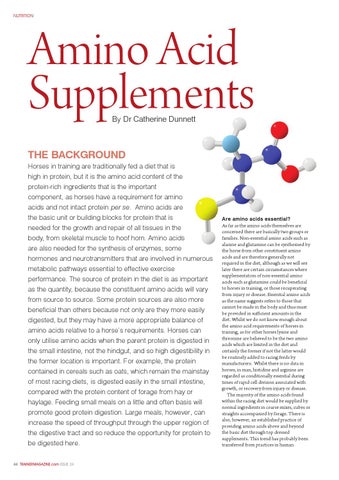AMINO ACIDS.qxd:Jerkins feature.qxd
27/11/08
11:51
Page 1
NUTRITION
Amino Acid Supplements By Dr Catherine Dunnett
THE BACKGROUND Horses in training are traditionally fed a diet that is high in protein, but it is the amino acid content of the protein-rich ingredients that is the important component, as horses have a requirement for amino acids and not intact protein per se. Amino acids are the basic unit or building blocks for protein that is needed for the growth and repair of all tissues in the body, from skeletal muscle to hoof horn. Amino acids are also needed for the synthesis of enzymes, some hormones and neurotransmitters that are involved in numerous metabolic pathways essential to effective exercise performance. The source of protein in the diet is as important as the quantity, because the constituent amino acids will vary from source to source. Some protein sources are also more beneficial than others because not only are they more easily digested, but they may have a more appropriate balance of amino acids relative to a horse’s requirements. Horses can only utilise amino acids when the parent protein is digested in the small intestine, not the hindgut, and so high digestibility in the former location is important. For example, the protein contained in cereals such as oats, which remain the mainstay of most racing diets, is digested easily in the small intestine, compared with the protein content of forage from hay or haylage. Feeding small meals on a little and often basis will promote good protein digestion. Large meals, however, can increase the speed of throughput through the upper region of the digestive tract and so reduce the opportunity for protein to be digested here. 44 TRAINERMAGAZINE.com ISSUE 24
Are amino acids essential? As far as the amino acids themselves are concerned there are basically two groups or families. Non-essential amino acids such as alanine and glutamine can be synthesised by the horse from other constituent amino acids and are therefore generally not required in the diet, although as we will see later there are certain circumstances where supplementation of non-essential amino acids such as glutamine could be beneficial to horses in training, or those recuperating from injury or disease. Essential amino acids as the name suggests refers to those that cannot be made in the body and thus must be provided in sufficient amounts in the diet. Whilst we do not know enough about the amino acid requirements of horses in training, as for other horses lysine and threonine are believed to be the two amino acids which are limited in the diet and certainly the former if not the latter would be routinely added to racing feeds by manufacturers. Whilst there is no data in horses, in man, histidine and arginine are regarded as conditionally essential during times of rapid cell division associated with growth, or recovery from injury or disease. The majority of the amino acids found within the racing diet would be supplied by normal ingredients in coarse mixes, cubes or straights accompanied by forage. There is also, however, an established practice of providing amino acids above and beyond the basic diet through top dressed supplements. This trend has probably been transferred from practices in human
